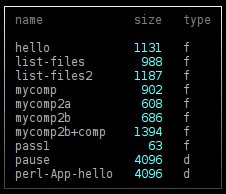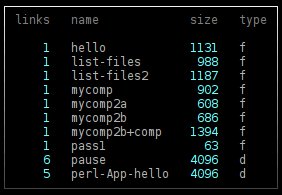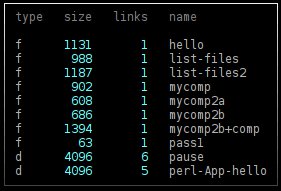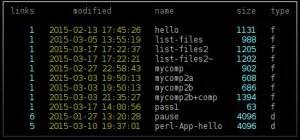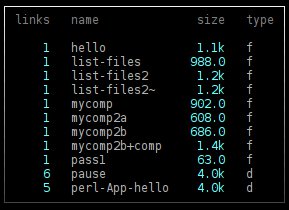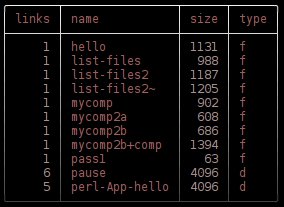Continuing from previous post, if we use Perinci::CmdLine::Classic as a backend, there are a few other options to customize table output. Let’s use the same list-files script, but use the classic backend:
% PERINCI_CMDLINE_ANY=classic ./list-files -v
You’ll notice that compared to the default Perinci::CmdLine::Lite’s output (which uses Text::Table::Tiny to produce the table), the Perinci::CmdLine::Classic’s output (which uses Text::ANSITable) is a bit fancier, e.g. colors and boxchars (and/or Unicode characters).
By default, Text::ANSITable colors columns differently according to data type. The second column, since it contains only numbers and thus is a numeric column, is colored cyan by default. While string columns are colored light grey by default.
Of course, like the lite backend, the classic backend supports reordering columns:
% PERINCI_CMDLINE_ANY=classic ./list-files2 -v
% PERINCI_CMDLINE_ANY=classic FORMAT_PRETTY_TABLE_COLUMN_ORDERS='[["type","size","links"]]' ./list-files2 -v
Aside from FORMAT_PRETTY_TABLE_COLUMN_ORDERS, there’s also FORMAT_PRETTY_TABLE_COLUMN_TYPES:
% PERINCI_CMDLINE_ANY=classic FORMAT_PRETTY_TABLE_COLUMN_TYPES='[{"modified":"date"}]' ./list-files3 -v
The mentioned list-files3 is exactly the same as list-files2 except that it adds a column modified containing mtime Unix timestamp of file. By default will be shown as a number (cyan), but with the above FORMAT_PRETTY_TABLE_COLUMN_TYPES hint the column is shown as a date (yellow).
Note that there is some heuristics employed, so if you name the column “mtime” or “something_date”, you don’t have to give any hint to show the column as date.
There is also FORMAT_PRETTY_TABLE_COLUMN_FORMATS to apply some formatting to columns, for example:
% PERINCI_CMDLINE_ANY=classic FORMAT_PRETTY_TABLE_COLUMN_FORMATS='[{"size":[["num",{"style":"kilo"}]]}]' ./list-files2 -v
The POD for Data::Format::Pretty::Console describes these options in more details.
Aside from these, the Text::ANSITable module itself provides lots of options to configure its output. For example, to choose border style and color theme:
% PERINCI_CMDLINE_ANY=classic ANSITABLE_BORDER_STYLE="Default::csingle" ANSITABLE_COLOR_THEME="Tint::tint_red" ./list-files2 -v
With Text::ANSITable you can also customize cell padding/spacing, column widths, or alignments. You can hide some columns/rows, repeat some columns/rows, or even do conditional styles involving Perl code. For more available options, refer to the POD.
